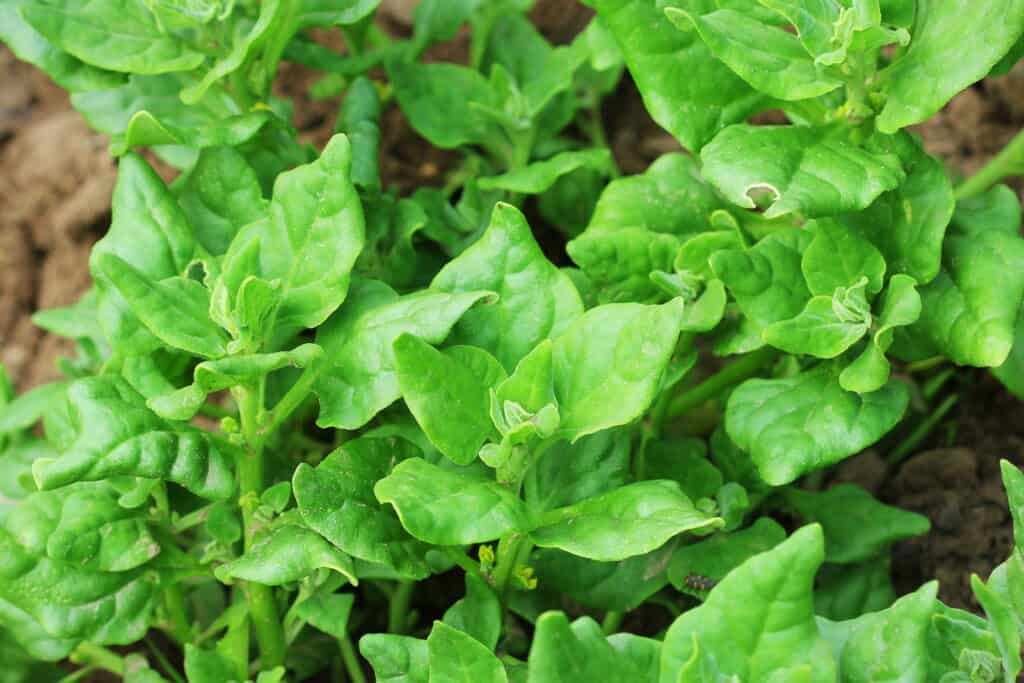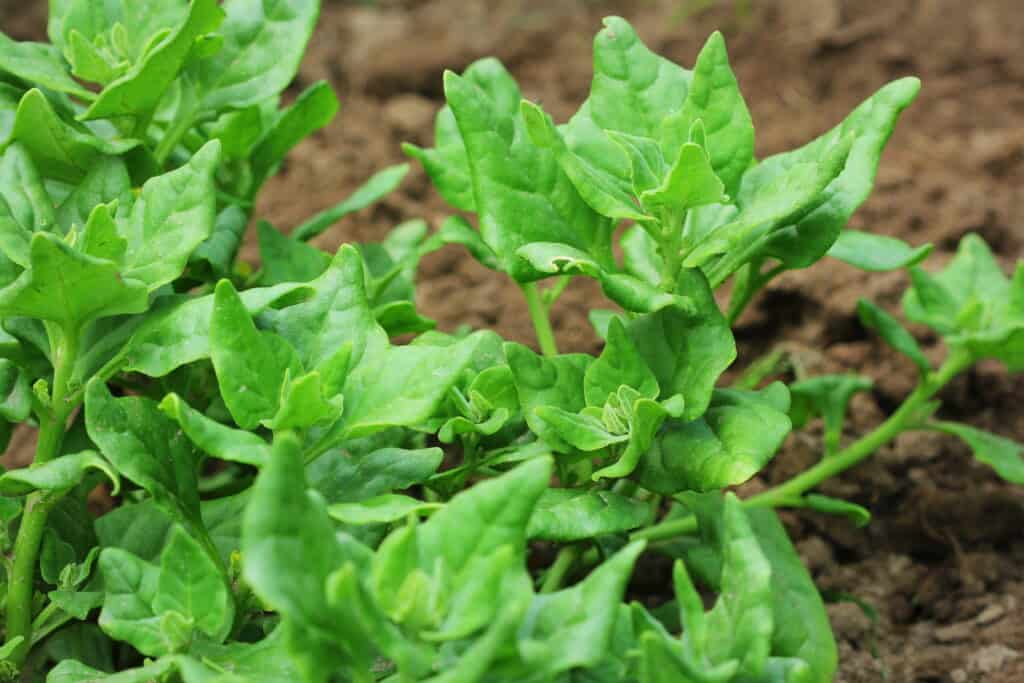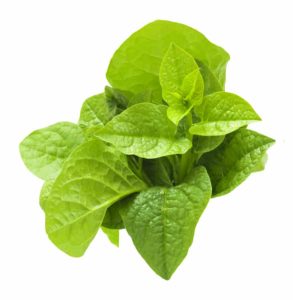New Zealand spinach is a perennial grown as a warm-weather annual. Plant New Zealand spinach in the warm part of the year when regular spinach will not grow. The two plants are not related but can be used fresh or cooked in the same way.
New Zealand spinach is a warm-season leafy green that should be planted after the last frost when soil temperatures reach at least 60°F (16°C). Start seeds indoors 3 to 4 weeks before the last expected frost or sow them directly in the garden once the soil warms up. Soak seeds in water for 24 hours before planting to improve germination. Plant the seeds ½ inch deep and space them 12 to 18 inches apart. New Zealand spinach prefers full sun and well-drained soil. Water consistently and provide a mulch layer to retain soil moisture, and it will thrive throughout the warm summer months.
Related articles:
- How to Plant, Grow, and Harvest Malabar Spinach
- Six Ways to Cook and Search Spinach
- How to Harvest and Store Spinach
- How to Plant and Grow Spinach

Here is your complete guide to growing New Zealand spinach!
New Zealand Quick Growing Tips
- Sow New Zealand spinach in the garden about the date of the average last frost in spring or later.
- It can be started indoors 2 to 3 weeks before the last frost in spring for later transplanting.
- New Zealand spinach yield: grow one or two New Zealand spinach plants per household member.

Where to Plant New Zealand Spinach
- Plant New Zealand spinach in full sun. New Zealand spinach prefers moisture-retentive, well-drained soil rich in organic matter.
- New Zealand spinach is weak-stemmed and will appear to trail across the garden.
- Set plants in hills similar to squash.
- New Zealand spinach prefers a soil pH of 6.8 to 7.0.
- Prepare planting beds with well-aged compost.
- Where summer heat is intense, plant New Zealand spinach where it will get partial shade in the afternoon.
New Zealand Spinach Planting Time
- New Zealand spinach grows best as a warm-weather annual in temperatures ranging from 60° to 75° F (16-24° C).
- Sow New Zealand spinach in the garden about the date of the average last frost in spring or later. Start New Zealand spinach indoors 2 to 3 weeks before the last frost in spring for later transplanting.
- New Zealand spinach is not frost-hardy like true spinach. Plant New Zealand spinach in the warm part of the year when regular spinach will not grow.
- New Zealand spinach is drought tolerant but the leaves will not be as tender.
- New Zealand spinach requires 55 to 65 days to reach harvest.
Planting and Spacing New Zealand Spinach
- Sow New Zealand spinach ½ inch (12mm) deep and 2 to 4 inches (5-10cm) apart.
- New Zealand spinach grows from seed clusters that produce several seedlings, similar to beet seed.
- Soak seeds overnight in water to speed germination.
- When seedlings are 3 inches (7cm) tall, thin to the strongest seedlings, from 12 to 18 inches (30-45cm) apart.
- Set New Zealand spinach in hills similar to squash. This will allow the weak stem to sprawl.
- Space hills or rows 24 to 36 inches (61-91cm) apart.
New Zealand Spinach Companion Plants
- Grow New Zealand spinach with strawberries.
- Avoid planting New Zealand spinach in the shade of tall plants such as corn or pole beans.
Container Growing New Zealand Spinach
- New Zealand spinach will grow well in containers.
- Grow two plants in a 5-gallon (19 liters) pot.

Water and Feeding New Zealand Spinach
- Keep New Zealand spinach evenly moist; water regularly for rapid, full growth. Do not let the soil dry out.
- New Zealand spinach is drought tolerant once established but leaves will not be as tender or flavorful.
- Mulch to retain soil moisture.
- Prepare planting beds with aged compost.
- Side dress plants with aged compost at midseason.
New Zealand Spinach Pests and Diseases
- New Zealand spinach has no serious pest problems.
- New Zealand spinach has no serious disease problems.
 Harvesting New Zealand Spinach
Harvesting New Zealand Spinach
- New Zealand spinach will be ready for harvest 55 to 65 days after sowing.
- Cut young leaves and tender leaf tips for the best flavor.
- This cut-and-come-again harvest will encourage new growth and longer harvest.
Storing New Zealand Spinach
- New Zealand spinach will keep in the refrigerator for up to one week.
- New Zealand spinach can be frozen canned or dried.
New Zealand Spinach Varieties
- ‘Maori’ is the most commonly grown variety.
About New Zealand Spinach
- Description. New Zealand spinach is a perennial vegetable grown as a tender annual. It is a low-growing, weak-stemmed leafy plant that can spread several feet wide and grow to one foot tall. It has succulent, triangular- to oval-shaped leaves that are pale to dark green and grow from 2 to 4 inches (5-10cm) long. The leaves of New Zealand spinach are smaller and fuzzier than those of regular spinach. New Zealand spinach has small yellow flowers and conical capsules.
- Common name. New Zealand spinach
- Botanical name. Tetragonia tetragoniodes
- Origin. New Zealand
Spinach articles on Harvest to Table:
How to Harvest and Store Spinach
Spinach Growing Problems: Troubleshooting
Six Ways to Cook and Serve Spinach
How to Grow New Zealand Spinach
Garden Planning Books at Amazon:
- Vegetable Garden Almanac & Planner
- Kitchen Garden Grower’s Guide Vegetable Encyclopedia
- Vegetable Garden Grower’s Guide
- Tomato Grower’s Answer Book
More how to grow articles:
Learn how to plant, grow, and harvest your favorite vegetables. Click below for all you need to know.
- Artichoke
- Arugula
- Asparagus
- Beans, Snap
- Beets
- Broad Beans
- Broccoli
- Brussels Sprouts
- Cabbage
- Cantaloupe — Melons
- Cardoon
- Carrots
- Cauliflower
- Celeriac
- Celery
- Chard
- Chayote Squash
- Chickpeas
- Chicory
- Chinese Cabbage
- Collards
- Corn Salad
- Corn, Sweet
- Cresses
- Cucumbers
- Eggplant
- Endive and Escarole
- Fava Beans
- Florence Fennel
- Garbanzo Beans
- Garlic
- Horseradish
- Jerusalem Artichoke
- Kale
- Kohlrabi
- Leeks
- Lettuce
- Lima Beans
- Melons
- Mizuna
- Mustard Greens
- New Zealand Spinach
- Okra
- Onions
- Parsnips
- Peanuts
- Peas
- Peppers
- Potatoes
- Pumpkins
- Radicchio
- Radishes
- Rhubarb
- Rutabaga
- Salsify
- Shallots
- Sorrel
- Southern Peas
- Soybeans
- Spinach
- Squash, Summer
- Squash, Winter
- Sunchokes
- Sweet Potato
- Swiss Chard
- Taro
- Tomatillo
- Tomatoes
- Turnips
- Watermelon
- Zucchini

 Harvesting New Zealand Spinach
Harvesting New Zealand Spinach

